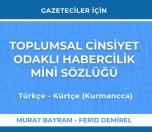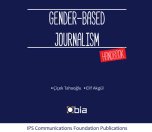Click to read the article in Turkish
We’ve discussed overstepping in “reports of violence against women and children” in 3 P Autumn School organized A&B Thought Workshop in French Culture Center on September 8-9 2017 with the theme BORDERS.
There are lots of elements such as choice of image, usage of headline, news content in the written/digital reports on presentation, reproduction and normalization of violence against women in media.
Despite ethical declarations of journalism professional organizations, academic studies and respective guidelines, it is seen that sexist language and patriarchic ideology’s borders are not abandoned even though on the surface it looks like the murders are condemned.
The headlines “Corpse of hitchhiker bride was found” used in homicide of “Peace Bride” Pippa Bacca who was murdered in 2008, and “she entered luxurious plaza with two men and then…” used in homicide of Şule Çet who was thrown down from 20th floor of a plaza in May 2018, repeat cliché of pudicity in femicides and once again violate the rights of victims and their acquaintances.
Just like the news report published with words “They should have protected their daughter” of then Security Director Celalettin Cerrah about Münevver Karabulut, who was murdered in 2009, the headlines “Spy or Courier?” , “What was she doing by herself?”, “I wanted to kiss but she didn’t allow” used in homicide of Sarai Sierra, who was killed in Turkey where she came for vacation, are among the “reports that cross the line” in memories of femicides.
In addition to figures like Ayşe Paşalı, Özgecan Aslan, Ceylan Timuroğlu who are most mentioned in the news, names of thousands of women whose stories were ended by men are included on “Anıt Sayaç” media, which is online since 2008.
Even though there are clauses in declarations of Press Council and Journalists Association of Turkey claiming that they will stand against all sorts of discrimination and they will avoid doing publications that promote violence and tyranny, there are many examples that nullify these clauses in killings of women and trans individuals.
As well as many media outlets, declaring that they took over press occupation principles from Doğan Media Group, Demirören Media Group pledges to protect similar ethical principles. Despite these declarations of ethics, studies of a large number of academics on nation-wide media organizations’ journalism terminology in femicides mirrors perspective of these media outlets which describe themselves as mainstream to these murders.
The language of mainstream that almost normalizes femicides in fact verifies description of discourse and ideology expert van Dijk: “Implications and allusive statements are as or even more important than what is said in terms of construction of ideology”.
Is it not possible to say that the headlines like “She became victim of jealous husband”, “She didn’t make up and I killed”, “She didn’t get married, she was murdered” which imply that women always have some fault (!) to be killed has the function of encouraging violence and tyranny like the campaign run to revoke the law no. 6184 that protects women who are subjected to violence.
Journalist suffering/causing loss of right
The relation of the sexist language used in the news to the patriarchal ideology and, especially, to the misogynist discourse of the political power has been long discussed and disputed.
In addition to that, behind this news language lie a number of other factors such as the change in the ownership structure of the media; inability to raise expert journalists; very low number of women among the executive ranks; pressure of being read/clicked; low wages; long and tiring tempo; title/content choices of the editor; copy-paste title and contents.
Guides on right news, right words
The guides such as “Woman and Media: Gender Equalitarian News Guide” (Kadın ve Medya: Toplumsal Cinsiyet Eşitlikçi Haber Kılavuzu) prepared by the Turkish Journalists’ Association (TGC); “Gender-Based Journalism Handbook” by bianet; “Using the Right Words: Creating News on Sexual Violence” (Doğru Kelimeleri Kullanmak: Cinsel Şiddet Üzerine Haber Oluşturmak) by the Association for Struggle Against Sexual Violence are important sources in transforming the news language.
According to the Gender-Based Journalism Handbook of bianet, the mistakes frequently made in reporting the news on violence against women can be listed as follows:
Making excuses on behalf of the culprit
The cliche of frenzy
Romanticizing violence
Disclosing the victim, rather than the culprit or violation
Empathizing with the aggressor, trying to justify, understand the acts of violence
Detailed use of expressions used in reports on scene of incident or in forensic reports
Pornographizing the news
Use of sexist expressions
Each one of these guides first identifies the problematic areas and moves on to present examples of gender equality- and rights-based journalism by providing information regarding how to choose the titles and photographs of a news report and what words to use or to prevent in writing the news. With these qualities, these guides make a strong impression as guiding sources that have to be owned and used by every journalist.
Recommendation by health organizations
Regarding the presentation of violence news in the media, experts have been reminding that the victims of violence incidents and their relatives were exhibited in the news in ways that they did not want to be seen and were totally out of their controls for hundreds of times before. For that reason, experts and health organizations recommend that these news be reported without providing detailed information on their identities, the method of violence as well as photographs and videos.
Exemplary social media work
The impact of social media has been changing journalism as well as the production and sharing of the news. Apart from the news, the interest in works and posts regarding femicides has also been increasing.
One of these works is called “No Estamos Todas” (We are not all here), which has been initiated by two women painters in Mexico for the memory of the women killed in their country and in the world. They have been sharing one illustration for each murdered woman so that these women do not solely remain as a number. The works of the women painters were shared on their Facebook, Twitter and Instagram accounts. There is also an illustration created for Özgecan Aslan.
Not So, But So Image Pool
The Association for Struggle Against Sexual Violence has been also planning to create an image pool with the aim of providing images with right messages to be used in the news on sexual violence. It seems that this pool will fill an important gap.
In its announcement, the association has stated that it has “taken the undeniable impact of communication and solidarity on social media into consideration” and announced that it has created the idea of an image pool “with the aim of encouraging the journalists to use images that are produced with a rights-based journalism understanding, are empowering and give the right messages in sexual violence news.” The image pool of the association, which has been still in preparation phase and open to contributions in the form of images in different categories, and the effective use of this pool seem to be as worthy of following as other works done for the transformation of news language. (AT/BK/TK/SD)








